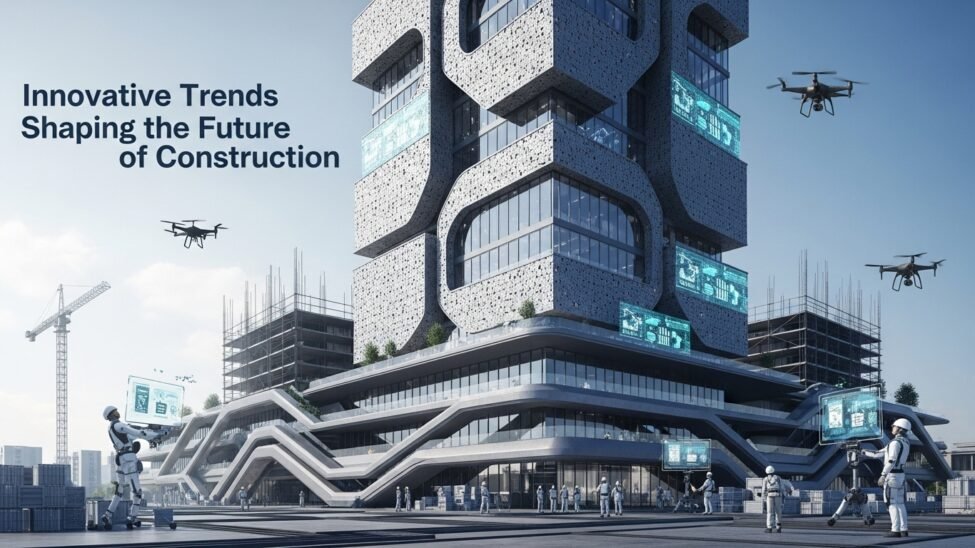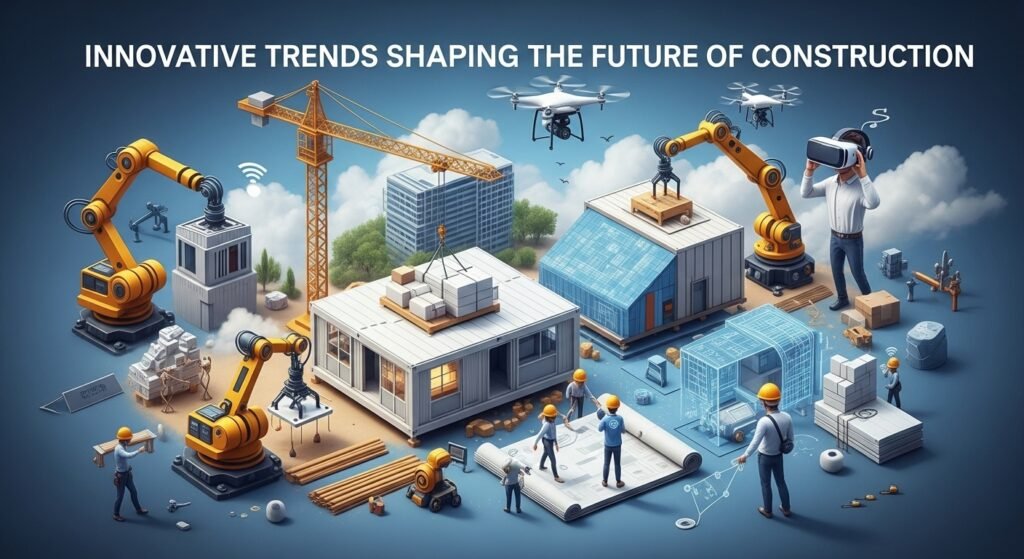
Building Tomorrow: Innovative Trends Shaping the Future of Construction
As we stand on the brink of a new era, the world of construction is undergoing a remarkable transformation. Innovative technologies, sustainable practices, and collaborative approaches are reshaping the way we build our future. Together, we can embrace these advancements and create structures that not only define our skyline but also reflect our values and aspirations. Join us on this journey to explore the trends that are paving the way for a more sustainable and resilient tomorrow.
Main Points
- Emerging technologies revolutionizing construction methods.
- The importance of sustainability in building practices.
- Collaboration and community engagement in project development.
The Rise of Sustainable Construction: Eco-Friendly Practices for a Greener Future
In today’s world, we are witnessing an inspiring shift towards sustainable construction. This movement embraces eco-friendly practices, paving the way for a greener future. As we strive to build better, we must not forget the importance of remodeling our existing structures. This approach not only reduces waste but fosters innovative design solutions. By focusing on renewable materials, energy-efficient technologies, and sustainable practices, we can transform our living environments into harmonious spaces that benefit both people and the planet.
- Use of green materials: Select timber and recycled metals to minimize environmental impact.
- Energy efficiency: Implement solar panels and better insulation for reduced energy consumption.
- Water conservation: Integrate rainwater harvesting systems to promote efficient water usage.
A Call to Action
As we embrace sustainable construction, let’s commit to being part of this vital change. Together, we can create spaces that reflect our values and respect our planet.
Embracing Smart Technology: How IoT and AI are Revolutionizing the Construction Industry
We stand on the brink of a *revolution* in construction. Through smart technology, IoT and AI are not just buzzwords; they are transforming our projects into interconnected systems. Imagine sensors actively monitoring environmental conditions, ensuring safety, and optimizing resources. This innovation enables us to enhance efficiency, reduce waste, and overall rethink how we approach *remodeling* challenges. As we embrace this digital era, let’s create buildings that resonate with intelligence and sustainability.
Modular Construction: Exploring the Benefits of Prefabricated Building Solutions
In today’s world, modular construction stands out as a revolutionary approach to building. We often overlook the remodeling possibilities that prefabricated solutions offer. Imagine efficiently constructed spaces that minimize waste while maximizing durability. By embracing this innovative method, we gain not only speed but also versatility. It allows us to adapt our designs, transforming any vision into reality. Ultimately, modular construction is about creating environments that serve our needs, aligning perfectly with our desire for change and development.
The Impact of 3D Printing on Construction: Redefining Traditional Building Methods
In recent years, we have witnessed a remarkable transformation in construction through 3D printing. This technology redefines how we think about building. It offers us innovative solutions that not only save time but also reduce costs significantly. We are entering an era where creativity meets efficiency, allowing us to reimagine structures. By embracing this trend, we pave the way for sustainable practices and unique designs. However, not everyone is convinced yet.
Key Advantages of 3D Printing in Construction
- Speed: Projects can be completed in a fraction of the time.
- Cost-efficiency: Significant savings on materials and labor.
- Customization: Tailored designs to fit specific needs and preferences.
As we explore these advantages, it’s clear that remodeling and innovation go hand in hand. Let’s embrace this change while staying mindful of the challenges that lay ahead.
Improving Safety and Efficiency: The Role of Drones in Modern Construction Projects
In today’s construction landscape, drones are revolutionizing how we approach projects. They provide us with an aerial perspective that enhances safety by identifying hazards before work begins. Moreover, their efficiency allows us to streamline tasks that once took hours into mere minutes. As we embrace this technology, we also improve collaboration among teams on-site, ensuring everyone stays informed. It’s clear that integrating drones transforms our processes, making construction safer and more efficient than ever before.
Unlocking New Possibilities
Embracing innovation like drones truly elevates our approach to construction. We connect with our objectives while ensuring precision and timely delivery on every project. Together, let’s redefine what’s possible and prioritize safety and efficiency in our endeavors.
When it comes to remodeling, the use of drones offers unique insights that can enhance planning and execution. By capturing detailed images, we can make informed decisions on remodeling initiatives, ensuring that every aspect is meticulously planned. Ultimately, modern challenges in remodeling can be met with these advanced tools, leading us to a more successful, efficient future.
Navigating the Skills Gap: The Importance of Workforce Development in Construction Innovation
In the rapidly evolving construction landscape, we face a significant challenge: the skills gap. As innovation drives our industry forward, it is crucial that we invest in workforce development. This значит not just providing training, but fostering a culture that embraces change and encourages continuous learning. Together, we can prepare our workforce for the future, ensuring that we meet the demands of modern construction.
“The future belongs to those who prepare for it today.” – Malcolm X
By focusing on mentorship and hands-on experience, we can inspire the next generation of builders. After all, it is not only about the blueprints but about the people who bring visions to life. So, let’s prioritize our efforts and close this gap. It is our collective responsibility.
| Key Focus Areas | Benefits |
|---|---|
| Remodeling | Enhances skills, fosters creativity |
| Technology Integration | Improves efficiency, reduces costs |
| Sustainable Practices | Promotes environmental responsibility |
In conclusion, bridging the skills gap in construction is not just an option; it is a necessity. When we work together, we pave the way for a brighter, more innovative future.
Regulatory Challenges and Opportunities: Adapting to Change in a Dynamic Construction Landscape
In a rapidly evolving construction environment, we face both regulatory challenges and opportunities. Embracing change means understanding the intricacies of new regulations while leveraging them to our advantage. As industry professionals, we must navigate this landscape with agility, ensuring our projects remain compliant yet innovative. Let’s explore key points that can guide our adaptation:
- Regulatory Awareness: Staying informed about local and national regulations is crucial for compliance.
- Collaboration: Engaging with stakeholders early in the process can help us identify potential hurdles.
- Continuous Learning: Ongoing education in regulatory developments fosters an adaptable mindset.
By integrating these elements, we can turn challenges into avenues for growth, ensuring our projects not only meet standards but set new benchmarks in the field of remodeling.
Conclusion

In conclusion, the world of construction is ever-evolving and brings both challenges and opportunities. Understanding the nuances of this field is essential for anyone looking to make an impact. While it may seem daunting at times, embracing these changes can lead to innovative solutions and sustainable practices. Furthermore, collaboration and open communication among stakeholders greatly enhance the efficiency of construction projects. Ultimately, we must adapt to new technologies and methodologies to thrive in this dynamic environment. Therefore, as we move forward, let’s maintain a focus on fostering growth and creativity within the construction industry.
Frequently Asked Questions
What are the key steps in the construction process?
The key steps in the construction process include planning and design, obtaining permits, site preparation, construction, and final inspections.
How long does a typical construction project take?
The duration of a construction project varies widely based on its size and complexity, but it can range from a few months to several years.
What are some common challenges faced during construction?
Common challenges include budget overruns, delays due to weather, supply chain issues, and compliance with regulations and safety standards.
How can I choose the right contractor for my project?
To choose the right contractor, research their reputation, check references, review past projects, and ensure they are licensed and insured.
What should I consider when planning a construction budget?
When planning a construction budget, consider costs for materials, labor, permits, inspections, contingency funds, and any unforeseen expenses.





